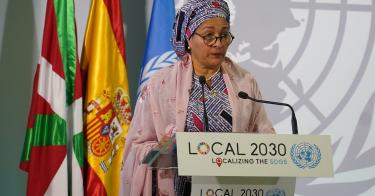Much angst is being expressed over the fact that the United Nations’ Sustainable Development Goals (SDGs) are off track. U.N. Secretary General António Guterres sounded the alarm in July: “Halfway to the 2030 deadline the world is woefully off-track…progress on fully half of all SDG targets is weak and insufficient. Almost a third have stalled or gone into reverse.”
True to form, the U.N. has scheduled a high-level summit on the SDGs during its annual General Debate, where most of the world’s leaders are scheduled to speak. Although there is hoopla about “new ideas” to save the SDGs, these ideas mostly focus on asking for more money, much of it from the United States. The secretary general claims, “The annual SDG funding gap has risen from $2.5 trillion before the pandemic to an estimated $4.2 trillion.”
This is a staggering amount of money for a failed endeavor. More money will not get the SDGs on track, because they were hopelessly flawed from the start.
The U.N. adopted the SDGs in 2015 as the successor to the expiring Millennium Development Goals. The MDGs, adopted at the Millennium Summit in 2000, had eight goals, 21 targets, and 60 indicators that were primarily aligned with pre-existing development objectives like improving primary school completion rates and access to safe drinking water and sanitation.
>>> The United Nations’ Agenda 2030 and the Sustainable Development Goals Fall Flat
Although U.N. boasts of success under the MDGs were overstated, progress was indeed made in reducing extreme poverty—largely driven by growth in China and India. Progress was uneven in other areas such as malnutrition and women’s equality.
However, the MDGs were plagued by poor data quality, data gaps, and questions about whether the measures were driving progress or merely tracking it.
All these issues apply in spades to the SDGs. Established by the 2030 Agenda for Sustainable Development, the SDGs immodestly aim at “transforming our world.” They are premised on unrealistic intents and encompass sweepingly impractical objectives.
The eight goals, 21 targets, and 60 indicators of the MDGs are a model of modesty and focus compared to the 17 goals, 169 targets, and 231 indicators of the SDGs. In addition to the expanded number, the nature of the goals also expanded. It was no longer acceptable to focus on traditional development goals like increasing employment, per capita income, literacy, life expectancy, access to water and sanitation, etc. To address the “complex nature” of poverty, the SDGs needed to include urbanization, substance abuse, climate change, mental health, tobacco use, sustainable tourism, and much more.
In many cases, the SDG targets are hopelessly ambitious. The SDGs aim grandly to “end poverty everywhere,” “end hunger,” “end child labor in all its forms,” “eliminate gender disparities,” “eliminate all forms of violence against all women and girls in public and private spaces,” and “eliminate slums.” These are not realistic goals; they are wishful aspirations.
Then there is the problem of subjectivity. The SDGs are replete with imprecise goals and targets such as “substantially reduc[ing] corruption and bribery in all their forms.” What qualifies as substantial reduction?
>>> U.N. Report Castigates Religion for Stymieing the Sexual Orientation-Gender Identity Agenda
Worse, as with the MDGs, the SDGs suffer from poor data quality and huge data gaps. As noted by the World Bank, “When the global indicator framework for the SDGs was adopted by the U.N. General Assembly in 2017, 84 (36%) out of the 231 indicators did not have any internationally established methodology or standards.” While attempts have been made to fill in these holes, many countries, particularly the developing countries where the indicators are supposed to measure progress, simply have not reported data in a robust, verifiable manner—if they report it at all.
More fundamentally, however, the SDGs are not a development strategy. As one economic analysis found, “The theoretical foundation of SDGs is weak and a comprehensive sustainable development theory does not exist. Instead, there are different contested theoretical approaches and definitions. The SDGs provide a list of targets, with no clear priorities and no theory on how these goals can be attained.”
At best, the SDG indicators are measures of progress toward development. For the U.N. to claim that the SDGs are driving development or transforming the world is akin to saying the speedometer is making the car move. Except it’s worse. At least the speedometer is an accurate and objective measure. The SDGs measure so many things so imperfectly that they defy application as a development strategy.
Which brings us back to the price tag. The secretary general is demanding that the world fill a financing gap of over $4 trillion annually. This is tantamount to doubling down on a bad bet. The U.S. should not endorse this outrageous demand. Instead, the U.S. should call out the SDGs for their ineffectiveness and call for a re-evaluation of this failed endeavor.
This piece originally appeared in 1945



